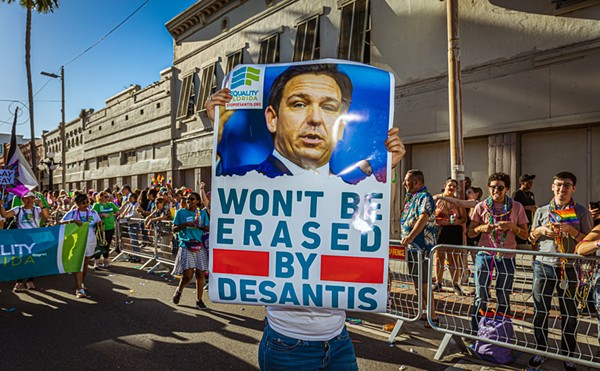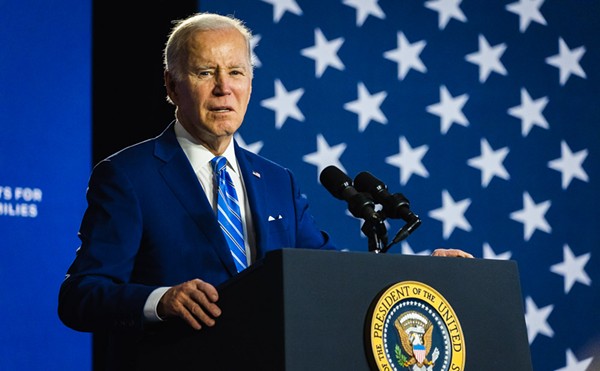Ride-sharing services have been making news for a while now, but it’s only in recent months that they’ve established a presence in Tampa Bay.
San Francisco-based Lyft began operating in Hillsborough on April 4 and quickly added Pinellas. UberX cars started showing up in Tampa and St. Pete a week later. Regulatory authorities are alarmed (especially in Hillsborough) and taxi drivers are angry, but word of mouth from riders is positive.
After four trips between my home in Tampa’s V.M. Ybor neighborhood and downtown Tampa — one with Uber, one with Lyft, and one with each of two local cab companies — I’m beginning to understand why.
Ride #1: UberX. Friday, June 20, early afternoon. After downloading the Uber app onto my Android phone and entering my credit card info, I placed a request for a ride from V.M. Ybor to the Straz Center. A moment later I was alerted via text message that my driver would be picking me up in eight minutes. Which is exactly what happened — and other than having to tell him not to take the Ashley Street entrance on to I-275 South, it was an extremely efficient ride. Cost: $6; $8 with tip.
Ride #2: Lyft. Friday, June 20, two hours later. “This is Bill, your Lyft driver,” the caller sunnily announced, informing me eight minutes after my request that he had arrived as promised, near John F. Germany Library. He said he was parked across the street from where I stood in the baking sun, at the corner of Ashley and Cass, and sure enough, there he was, waving from his black Prius — a picture of which Lyft had texted to me (along with a photo of Bill) as I tracked his progress on my phone via the Lyft app. Consulting the GPS coordinates on his Samsung, Bill then proceeded to take me to V. M. Ybor, talking about the feedback system (drivers and riders can rate each other via the app) and giving me the company’s traditional fist bump on departure. (His car did not sport Lyft’s traditional pink mustache; it was only his second day on the job, and a company spokesperson says that drivers only get to affix the ’stache onto their bumpers once they’ve completed 30 rides.) Cost: $6. (I couldn’t get the tip app to work.)
Rides #3 and 4: United and Yellow cabs. Tues., July 8, early afternoon. Attempting to retake the same route via taxicab, I called United. They kept me on hold for three minutes, so I called Yellow Cab at 12:14 p.m. requesting a ride from V.M. Ybor. Forty-five minutes passed. No cab. I called back twice, and each time was told no one had accepted the fare.
So I called back United. A text came three minutes later, and at 1:12 p.m. my United driver was waiting for me. After complaining that I had waited over 45 minutes for a ride, my cabbie told me he had heard that “a lot.” The ride to the Straz was smooth, and the charge was $8.50, $11 with tip.
I walked over to the John Germany Library, and decided to find out whether Yellow Cab behaved differently when a call was coming from downtown Tampa. The cab came less than 2 minutes later.
The fare was essentially the same. I asked my driver what he thought had happened the first time. “You live in the ’hood,” he told me. “Nobody is interested in getting fares out here.”
The Lyft and Uber drivers had no such problem with my address. They also responded to my ride requests quickly, picked me up promptly, and charged me less than the taxicabs did. All in all, these first two experiences with ride-sharing were absolutely different from any paid car rides I’d ever had. I sat in the front seat next to the drivers; no dollars were exchanged because I’d already registered my credit card info and pre-approved the cost of the rides; and the vehicles were owned by the drivers themselves.
No wonder the cab companies are scared.
There are a few problems with ride-sharing services, though. They’re not strictly legal. Concerns have been raised about driver insurance and background checks. And if you don’t have a credit card and a smartphone, you’re SOL.
In St. Petersburg, the authorities don’t seem to see a big problem.
According to Glenn MacKinnon, a revenue officer with the city’s business tax division, an Uber or Lyft vehicle would have to get a sticker and a driver permit, or hack license, from the police department, and pay the corresponding business tax. When CL pointed out that ride-sharing companies are already doing business in St. Pete without complying with those regulations, he replied, “Well, I don’t know that. I can tell you that nobody has complied with us over here. When maybe an officer stumbles across one working illegally, we’ll probably have to notify them and make sure that they’re fully on tap with being in compliance.”
My United cab driver in Hillsborough — let’s call him William — confirmed that the regulatory situation in Pinellas was a bit more, um, relaxed. There is no single agency regulating cabs in the county; the cops are charged with enforcing the rules, he said, but they’re more concerned with serious crimes. If an Uber driver were to kidnap or do something else nefarious with a passenger, he said, “They’ll start caring an awful lot more.” He said he actually prefers working with Hillsborough’s Public Transportation Commission (PTC), which oversees the taxi and limo industries in the county.
The PTC — the only such commission in any county in the state — is not a fan of ride-sharing. The agency has not certified Uber or Lyft, and its officials have issued at least 44 citations — some with fines as high as $800 — against 14 drivers. Last month PTC Executive Director Kyle Cockream upped the ante by asking both the Tampa Police Department and the Hillsborough County Sheriffs Office to help crack down on the scofflaws.
But two Republican state legislators — Rep. Jamie Grant and Sen. Jeff Brandes — are championing the services, claiming that they’re just the sort of innovation Hillsborough needs and that the PTC’s regulatory zeal is woefully out of touch with contemporary consumers’ needs.
When asked about Cockream’s request for law enforcement assistance, Grant told CL, “I wish that the PTC months ago would have been focused on more productive regulations that would help cultivate an innovative community here in Tampa rather than worrying about the ability to crack down on companies that they should have been embracing a year ago.”
That comment left Cockream steaming. “Mr. Grant, we were working on this months ago,” he said, speaking to CL in late June.
The two legislators have long been opponents of the PTC, having written a bill late last year that would have killed the agency (the commission was created via a special act by the Legislature), but their Hillsborough-area colleagues rejected the idea. Undeterred, they went on to craft bills to do away with the PTC’s $50 minimum fare for town cars, a longtime bone of contention, and the reason that Uber Black — the company's limo service — had been unwilling to come into the market.
Such minimal fares have been established to create a differential between taxis and every other car service. Taxis are required to provide services 365 days a year, 24 hours a day, 7 days a week. They cannot refuse a fare, they must take all forms of payment, and they must be reachable by phone and provide ADA access. Luxury car operators, on the other hand, don’t have to abide by any of those regulations — with the caveat being that they must charge some sort of minimum, at all times.
Cockream expresses frustration with Uber, saying they refuse to accept a minimum fare of any amount for Uber Black.
But Brian Willis, a Tampa attorney with the pro-transit group Connect Tampa Bay, says the PTC has fiddled on the minimum issue for far too long. “Uber and Lyft could have a billion dollars in insurance and hire off-duty police officers as drivers, and the PTC rules would still prevent them from operating,” he says with disdain.
Willis is a member of a younger generation that has embraced ride-sharing services and fueled their meteoric growth. He says Uber and Lyft offer an easier way to order and pay for a ride than a traditional cab does.
“Connect Tampa Bay has been fighting for the past year and a half for the principle that government should not be dictating to people how they travel around the region. We should have the right to choose how we get around, whether it’s a car, bus, rail, taxi, or Uber or Lyft vehicle. We should all be making that choice for ourselves, not the government.”
Tampa Heights resident Raj Patel agrees. He used to call for cab service to go to the Straz or other downtown locations, a ride of around a mile and a half. He’d be told the rides would come within 15-20 minutes, but often they never showed.
And the customer service, he says, is terrible. “God forbid you try to pay with credit card, which they are legally required to accept if their vehicles are equipped with card readers. You’ll be cursed at, lied to, and told that they do not accept credit cards even though there is a machine in the back seat of the vehicle facing right at you.”
Now Patel rides Lyft once a week. He’s taken the service to the airport, the Hard Rock Casino and downtown St. Pete.
And his drivers are likely to be people like Bill, who drove me from downtown Tampa to V.M. Ybor. A Riverview resident, he’s a Hillsborough County substitute school teacher, and because it’s summertime — no school, no “bennies” — he’s free to drive. He sticks mostly to the downtown and Ybor routes, and says it’s “pretty nice” to drive a Lyft car.
“A lot of nice people like yourself, all different walks of life and all kinds of people. It’s very interesting. It’s nice to be able to sit in the front seat with them instead of having to turn around like in a cab. This is a lot more personal. You’re giving a friend a lift. It is what it is. It’s a great concept.”
But Uber X and Lyft do demand a certain amount of trust from riders. Anyone approved by the sharing service is allowed to use his or her own car to provide rides. Hence the central controversy Uber in particular has had to contend with: insurance and background checks.
Uber now provides $1 million in primary coverage — when a driver is transporting a passenger. But the ride-sharing service was criticized earlier this year in California by state legislators for having an “insurance gap” — that a driver is only covered when he has a passenger, not when he has his app open and is looking for a new fare.
Uber has since clarified its insurance coverage, saying that it includes $50,000 per person, $100,000 maximum for injury and $25,000 for damages for the period when a driver has the UberX app open but no calls for service. But insurers object to that coverage (Lyft employs a similar strategy), because it only goes into play if a driver’s personal insurance company will not pay.
“What happens when my app is on, but I haven’t accepted a fare, and then you get into an accident?” asks Roger Chapin, a spokesman with Mears Transportation in Orlando. “Accidents happen, but in every taxicab, limo company or bus company, it doesn’t matter if you’re on or off the clock, if a taxicab driver is driving home and T-bones somebody in an intersection, the insurance [responsibility] goes with the [company that owns] the cab. But Uber doesn’t ‘own’ any cars, and that’s where I think there’s a lot of risk.”
Last year, the California Public Utilities Commission began requiring ride-sharing companies to carry commercial liability insurance, regardless of whether the driver is personally insured. The law mandated a minimum $1 million of coverage per incident. But experts say the rules did not clarify whether job-related activities — like checking requests for fares on a smartphone — were covered.
As for background checks, Uber spokesperson Natalia Montalvo says that each driver undergoes a three-step background check before accessing the Uber platform, including county, multi-state and federal checks going back over the past seven years.
The PTC is not alone its fight against ride-sharing companies. In Pittsburgh, for instance, Uber and Lyft are banned by the Public Utility Commission because they are considered a “threat to public safety.” But some cities have found a way to compromise.
In Seattle, Mayor Ed Murray announced an agreement between all the major industry players, allowing Lyft, Sidecar and UberX to operate with no limit on the number of drivers that can be on the street at any given time. The city’s original ordinance set a maximum of 150 active drivers per company, angering the ride-sharing companies.
Although the central issues are different in Tampa (where the number of drivers hasn’t been an issue), Mayor Bob Buckhorn says it’s time for the PTC to incorporate Lyft and Uber into its business model. “Technology is changing everything we do.
“I think competition is good. It’s good for the consumer. I think the rates will come down; I think the efficiency will go up. I like Uber and I like Lyft and I like incorporating them into our transportation methods, so I hope the PTC will move into at least the 18th century.”
But the PTC’s Cockream says the agency is well on its way to 21st-century improvements. The 50-year-old former Hillsborough County Sheriff officer says he’s working on bringing an L.A.-based technology company into Tampa with an app that allows you to select a service provider for any number of tasks.
And the taxicab industry is certainly not going down without a fight. Earlier this year the Florida Taxicab Association released a poll showing that Uber’s practice of serving only customers with smartphones and credit cards cuts out half of the public.
Lou Menardi is president of that group and the owner of Yellow Cab in Tampa. He has been critical of Uber’s entrance into the Tampa market, saying, “They could operate legally in Tampa tomorrow, without a doubt, [but] that’s not their platform. You’re either going to do it their way or the highway.”
Minardi, as old-school as it gets, says these companies’ app-based technologies (which he says local cab companies have offered for years now) could soon be a relic.
“You can get in and fist-bump. That’s cool now, or you can get up and head-butt, you can go and touch an ass if you want. But you know what I’m saying – things are going to change.”
He does acknowledge, however, that “our drivers have to pick up their game” so that the long waits and reluctant pick-ups of the type that I experienced aren’t a commonplace.
Jeff Brandes says Uber is part of the new “disruptive” economy that also includes the burgeoning popularity of indie craft breweries and apartment-sharing services like Airbnb.
“You’re seeing disruptive innovation taking off, and to me that’s incredibly exciting. These types of battles are just a natural reaction to that, but it’s exciting to see that,” he says.
No question, UberX and Lyft aren’t going away. Whether they’re willing to play ball with the PTC or continue going their own way remains to be seen.














